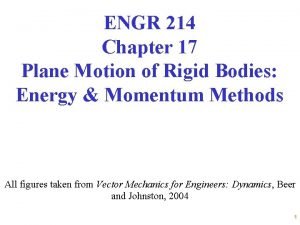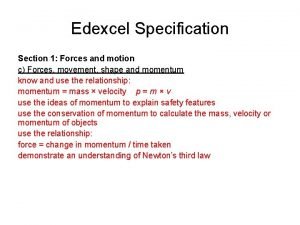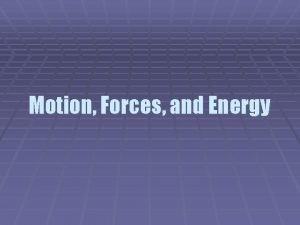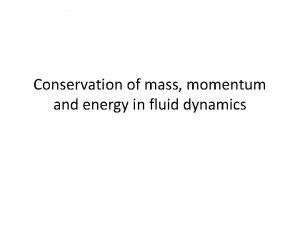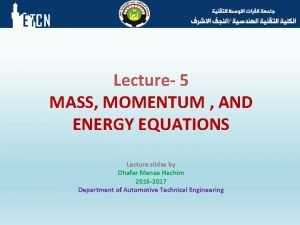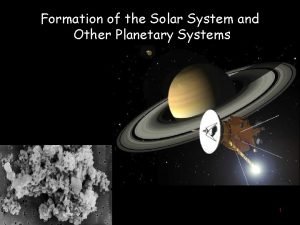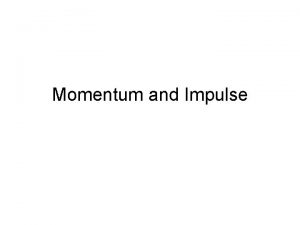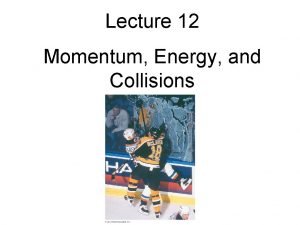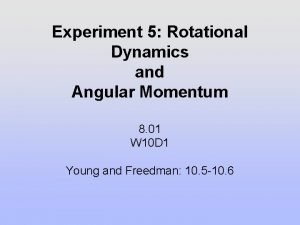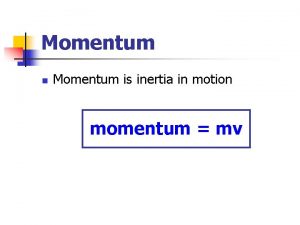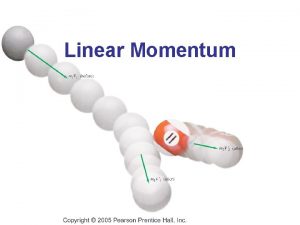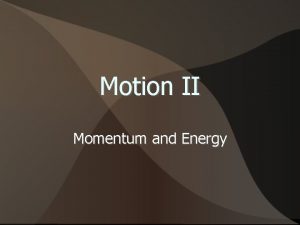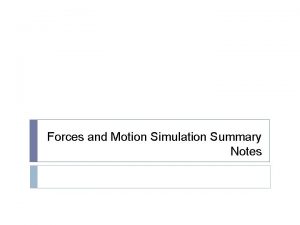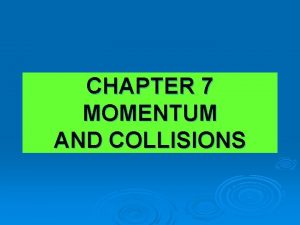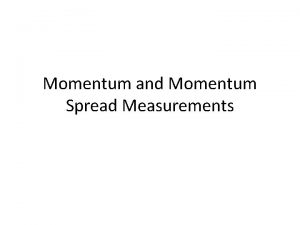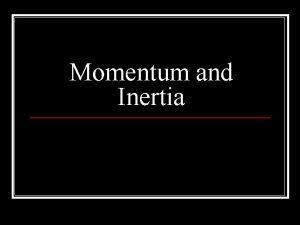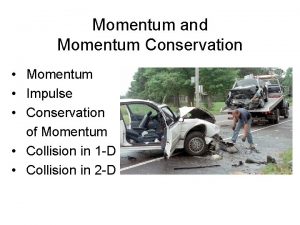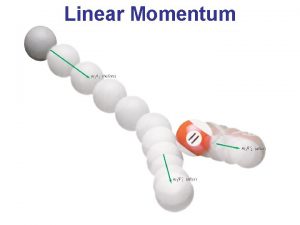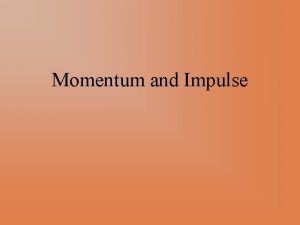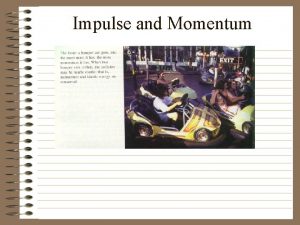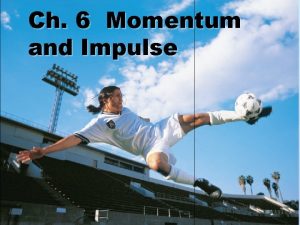Motion Forces and Energy Motion and Momentum Section






























- Slides: 30

Motion, Forces, and Energy Motion and Momentum

Section 1: What is motion? All matter is constantly in motion.

Motion involves a change in position… An object changes position if it moves relative to a reference point. To understand a reference point; 1) Picture yourself standing at the front office 2) Then, you walk to our classroom 3) When you reach our classroom, you have traveled about 50 meters 4) Since the office is where we started, it would be our reference point, because our position has changed 50 meters relative to the starting spot (the office) and motion has occurred

Distance and Displacement Distance is the total length of the route an object travels when it moves. Displacement includes distance and direction of the stopping point from the starting point.

Speed- the distance traveled divided by the time taken to travel the distance. Formula for speed: speed (s)= distance (d) / time (t) or s= d/t The for speed are meters per second (m/s). An object in motion can change speeds many times as it moves from one point to another, speeding up or slowing down.

Average Speed Average speed- equals the total distance traveled divided by the total time taken to travel the distance. Question: If it takes you 0. 5 h to walk 2 km to the library, what is your average speed? We solve this equation by using the s= d/t method: 1) Plug in the numerical digits into the equation 2) So, 2 km/0. 5 h = ? 3) 4 km/h

What is instantaneous speed? Instantaneous speed- the speed of an object at one instant of time.

How do you graph motion? Motion can be graphed on a distance-time graph with time plotted on the horizontal axis (x-axis or left to right) and distance plotted on the vertical axis (y-axis or up and down). The steeper the line on a distance-time graph, the greater the speed. A horizontal line on a distance-time graph indicates that no change in position is occurring and the speed is 0 m/s.


Velocity Velocity- speed of an object and its direction of motion; velocity changes if either, or both, of these changes. V= displacement (d) / time (t) or V= d/t

Section 2: :

Change in Velocity Each time you take a step you are changing the velocity of your body. You are probably most familiar with the velocity changes of a moving bus or car. Acceleration- change in velocity divided by the time for the change to occur; it can include an object’s speeding up, slowing down, and/or changing direction.

Calculating Acceleration Change in velocity = final – starting velocity Acceleration= final speed- starting speed time Or: a= (sf-si)/t Acceleration= change in velocity time

Calculating Acceleration (cont’d) The unit of acceleration is distance divided by time squared; (m/s 2). Acceleration is positive when an object speeds up. Acceleration is negative when an object slows down.

A car traveling at 60 mph accelerates to 90 mph in 3 seconds. What is the car’s acceleration? Acceleration = Velocity(final) - Velocity(original) time = = 90 mph - 60 mph 3 seconds 30 mph 3 seconds = 10 mph/second

A car traveling at 60 mph slams on the breaks to avoid hitting a deer. The car comes to a safe stop 6 seconds after applying the breaks. What is the car’s acceleration? Acceleration = Velocity(final) - Velocity(original) time = = 0 mph - 60 mph 6 seconds = - 10 miles per hour per second

Graphing Acceleration Accelerated motion can be graphed on a speed-time graph with speed on the vertical axis (y-axis or up and down) and time on the horizontal axis (x-axis or left to right). An object that is speeding up will have a line on a speedtime graph that slopes upward. An object that is slowing down will have a line on a speed-time graph that slopes downward. A horizontal line on the speed-time graph represents an acceleration of zero or constant speed.

Positive acceleration Negative acceleration

- A constant acceleration produces a straight line or linear slope (rise/run). - The slope of a velocity-time graph (rise/run) will predict an objects instantaneous acceleration. a = v/t

0 or constant speed

Galileo n 1600’s n Studied how things fell n Rolled balls down an inclined plane n Found that the speed increased as it rolled down the ramp

Galileo Acceleration= change in velocity time t=0 t = 1 second t = 2 seconds t = 3 seconds

Practice Problem # 1 n Calculate the acceleration of a bus whose speed changes from 6 m/s to 12 m/s over a period of 3 seconds. n What do we know: n Initial Speed: 6 m/s n Final Speed: 12 m/s n Time: 3 seconds

Practice Problem # 2 n Suppose you were riding your bicycle in a straight line and increased your speed from 4 m/s to 6 m/s in 5 seconds. Calculate your acceleration.

Practice Problem # 3 n Suppose you slow down from a speed of 4 m/s to 2 m/s in 5 seconds. Now the final speed is less than the initial speed. Calculate your acceleration.

Section 3: Momentum

Mass and Inertia Mass- the amount of matter in an object. The SI unit for mass is the kilogram Inertia- the tendency of an object to resist a change in its motion. Objects with more mass have more inertia, thus is harder to change its motion

Momentum- a measure of how difficult it is to stop a moving object; equals the product of mass and velocity. Momentum is usually symbolized by p Momentum= mass X velocity or p= mv Momentum has units of kg multiplied by m/s Since velocity includes direction, momentum has the same direction as velocity.

Practice Problem 1 Calculate the momentum of a 16 -kg bicycle traveling north at 3 m/s.

Practice Problem # 2 Calculate the momentum of a 12 -kg bicycle traveling east at 2 m/s.
 Section 2 velocity and momentum
Section 2 velocity and momentum Non centroidal rotation
Non centroidal rotation Section 3 motion and forces worksheet answers
Section 3 motion and forces worksheet answers Section 1 forces and motion answers
Section 1 forces and motion answers Motion forces and energy
Motion forces and energy Unit 3 force motion energy answer key
Unit 3 force motion energy answer key Conceptual physics momentum
Conceptual physics momentum Section 2 describing energy (continued)
Section 2 describing energy (continued) Like force
Like force What is contact force
What is contact force Force examples in everyday life
Force examples in everyday life Volcanoes constructive and destructive forces
Volcanoes constructive and destructive forces Chapter 2 motion section 1 describing motion answer key
Chapter 2 motion section 1 describing motion answer key What is acceleration
What is acceleration Section 1 describing motion worksheet answer key
Section 1 describing motion worksheet answer key Chapter 1 lesson 1 position and motion answer key
Chapter 1 lesson 1 position and motion answer key Section 1 describing motion
Section 1 describing motion Energy energy transfer and general energy analysis
Energy energy transfer and general energy analysis Energy energy transfer and general energy analysis
Energy energy transfer and general energy analysis The forces shown above are pushing/pulling forces
The forces shown above are pushing/pulling forces Intermolecular forces from strongest to weakest
Intermolecular forces from strongest to weakest Difference between intramolecular and intermolecular
Difference between intramolecular and intermolecular Intramolecular forces vs intermolecular forces
Intramolecular forces vs intermolecular forces Thermal energy section 3 using thermal energy
Thermal energy section 3 using thermal energy Chapter 8 section 1: how organisms obtain energy
Chapter 8 section 1: how organisms obtain energy Mass momentum and energy conservation
Mass momentum and energy conservation Conservation of mass momentum and energy equations
Conservation of mass momentum and energy equations Which statement best compares momentum and kinetic energy?
Which statement best compares momentum and kinetic energy? Momentum of center of mass formula
Momentum of center of mass formula A cannon sits on a stationary railroad flatcar
A cannon sits on a stationary railroad flatcar Linear momentum in circular motion
Linear momentum in circular motion

